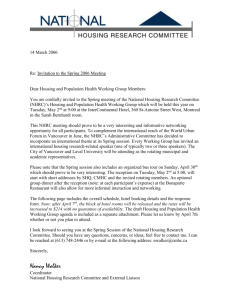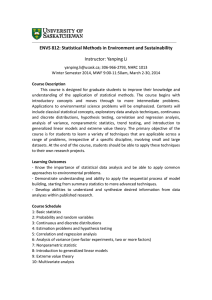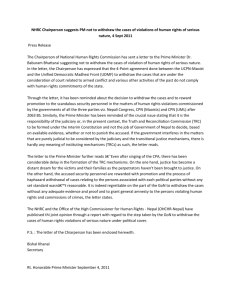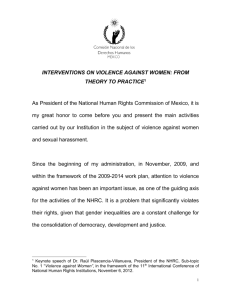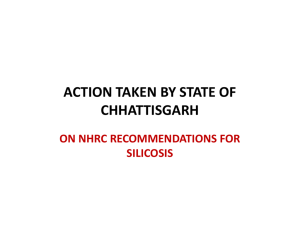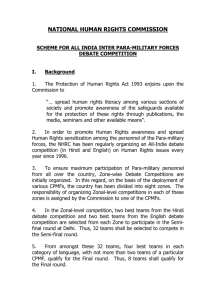Role of National Human Rights Commission in the Context of Review of Laws, Implementation of International Instruments of Human Rights
advertisement
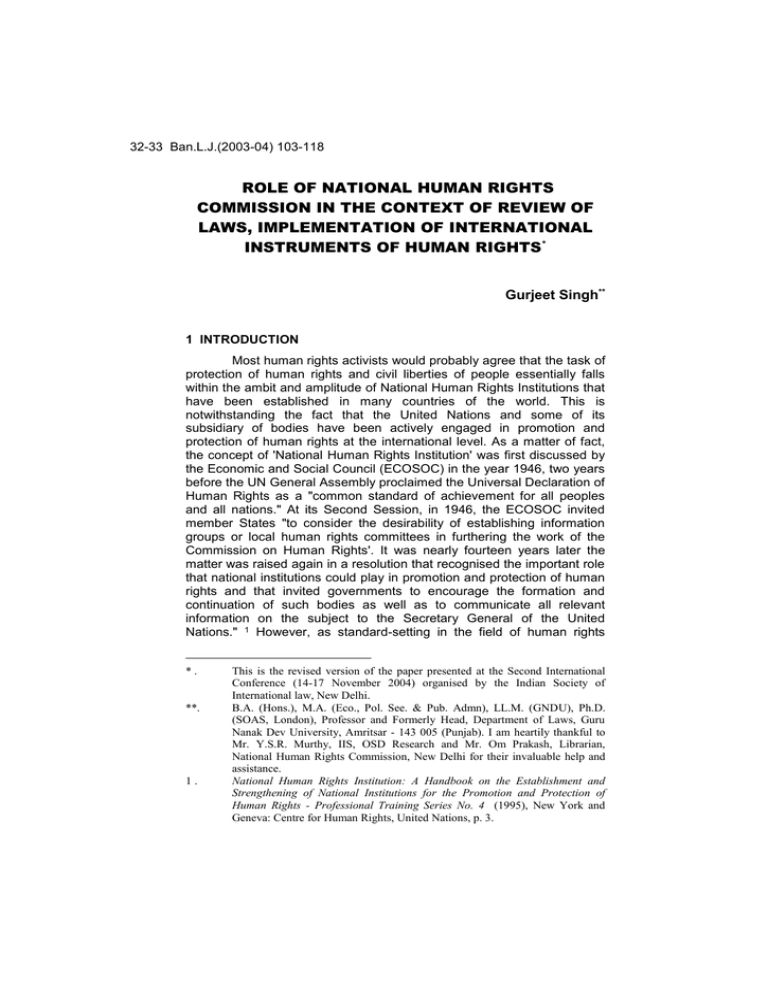
32-33 Ban.L.J.(2003-04) 103-118 ROLE OF NATIONAL HUMAN RIGHTS COMMISSION IN THE CONTEXT OF REVIEW OF LAWS, IMPLEMENTATION OF INTERNATIONAL INSTRUMENTS OF HUMAN RIGHTS* Gurjeet Singh** 1 INTRODUCTION Most human rights activists would probably agree that the task of protection of human rights and civil liberties of people essentially falls within the ambit and amplitude of National Human Rights Institutions that have been established in many countries of the world. This is notwithstanding the fact that the United Nations and some of its subsidiary of bodies have been actively engaged in promotion and protection of human rights at the international level. As a matter of fact, the concept of 'National Human Rights Institution' was first discussed by the Economic and Social Council (ECOSOC) in the year 1946, two years before the UN General Assembly proclaimed the Universal Declaration of Human Rights as a "common standard of achievement for all peoples and all nations." At its Second Session, in 1946, the ECOSOC invited member States "to consider the desirability of establishing information groups or local human rights committees in furthering the work of the Commission on Human Rights'. It was nearly fourteen years later the matter was raised again in a resolution that recognised the important role that national institutions could play in promotion and protection of human rights and that invited governments to encourage the formation and continuation of such bodies as well as to communicate all relevant information on the subject to the Secretary General of the United Nations." 1 However, as standard-setting in the field of human rights *. **. 1. This is the revised version of the paper presented at the Second International Conference (14-17 November 2004) organised by the Indian Society of International law, New Delhi. B.A. (Hons.), M.A. (Eco., Pol. See. & Pub. Admn), LL.M. (GNDU), Ph.D. (SOAS, London), Professor and Formerly Head, Department of Laws, Guru Nanak Dev University, Amritsar - 143 005 (Punjab). I am heartily thankful to Mr. Y.S.R. Murthy, IIS, OSD Research and Mr. Om Prakash, Librarian, National Human Rights Commission, New Delhi for their invaluable help and assistance. National Human Rights Institution: A Handbook on the Establishment and Strengthening of National Institutions for the Promotion and Protection of Human Rights - Professional Training Series No. 4 (1995), New York and Geneva: Centre for Human Rights, United Nations, p. 3. 104 THE BANARAS LAW JOURNAL [Vol.32-33 gained momentum during the 1960s and 970s, discussions on national institutions became increasingly focused on the ways in which such bodies could assist in the effective implementation of these international standards. Therefore, throughout the 1980s, the United Nations continued to take an active interest in this topic and a series of reports prepared by the Secretary General was presented to the General Assembly. It was during this time that a considerable number of national institutions were established many with the support of the United Nations Centre for Human Rights.2 It may be appropriate to mention here that UN has laid down a number of guidelines in regard to the establishment and functioning of National Human Rights Institutions and it is essentially on the lines of these guidelines that a number of Human Rights Commissions have been set up in different parts of the world. These institutions have "a very unique role in translating international human rights standards into reality, and giving them a local flavour and acceptability without diluting their essential universal characteristics."3 It was in lien with the various international guidelines on the subject that the Government of India enacted the Protection fo Human Rights Act, 1993 and thereby established the National Human Rights Commission with the sole aim of "better protection of human rights and for matters connected therewith or incidental thereto."4 Section 12(d) and (f) of the Protection of Human Rights Act, 1993 respectively enjoins upon the National Human Rights Commission to "review the Safeguards provided by or under the Constitution or any law for the time being in force for the protection of human rights and recommend measures for their effective implementation" and to "study treaties and other international instrument on human rights and make recommendations for their effective implementation." Its is in line with this mandate that the NHRC, ever since its establishment, has been playing its role in the context of review of laws, implementation of treaties, and other international instruments of human rights. As the discussion in the following paragraphs would indicate, it has been impressing upon the 2. 3. 4. Ibid., p. 4 Mohapatra, Arun Ray (2001): National Human Rights Commission of India: Formation, Functioning and Future Prospects. New Delhi: Radha Publications, p. 44. See: Preamble to the Protection of Human Rights Act, 1993. Gurjeet Singh, "Role of National Institutions and Non-Governmental organisations (NGOs) in Promotion and Protection of Human Rights - A Case Study of India." In: B.P.S Sehgal (ed.): Human Rights: Problems and Perspectives, New Delhi: Deep and Deep Publications (1995), pp. 58293; Gurjeet Singh, "Protecting and Promoting Human Rights of the People and Spreading Human Rights Culture in the Country: An Appraisal of the Role of National Human Rights Commission." 13 Aligarh Law Journal, Vol. (1998) pp. 1-27. 2003-04] NATIONAL INSTITUTIONS AND PROTECTION OF HUMAN RIGHTS 105 Government of India as well as upon various State Governments for taking appropriate measures in this regard. The views expressed by the NHRC have been highlighted in its Annual Reports as well as monthly newsletters and other publications. The present paper deals with the role and responsibilities performed by the NHRC in accordance with the statutory requirements in the context of review of laws, implementation of treaties, and other international instruments relating to human rights. The paper has been divided into four parts. Part 1 deals with introduction. Part 2 focuses on the role played by the NHRC as for as review of laws is concerned. Part 3 concentrates on NHRC's initiatives in the context of implementation of treaties and various international instruments relating to human rights. Part 4 contains my personal observations on the functioning and performance appraisal of the NHRC in the above context. II. REVIEW OF LAWS In accordance with its mandate under the Protection of Human Rights Act, 1993, the NHRC has been making sincere endeavours as for as review of some of the existing laws, implementation of treaties and various international instruments relating to human rights are concerned. An attempt has been made here under to discuss some of the initiatives taken by the NHRC in this regard. (i) The Child Marriage Restraint Act, 1929 The problem of the widespread prevalence of child marriage in certain parts of the country has been a major concern of the NHRC over a number of years. It has been interacting with the National Commission for Women and the Department of Women and Child Development to evolve suitable measures to combat this problem. As the Draft Marriage Bill jointly prepared by the National Commission for Women and Department of Women and Child Development did not find favour with the government, the NHRC decided to work on an amendment to the Child Marriage (Restraint) Act, 1929.5 The NHRC took the view that this Act should be recast so as to provide for higher penalty for the violation of the provisions of the Act. It look the view that a provision should be made in the amended Act to take action against organizers/associations who organise child marriages on a mass scale. 6 The NHRC recommended that it was necessary, first of all, to provide for registration of all marriages - whether religious or civil. Further, just as there were registers of births and deaths, there should be registers of marriages 5. 6. National Human Rights Commission Annual Report (1999-2000), New Delhi: NHRC, p. 43. Also see: "Full Commission Meeting Discusses Amendments to Child Marriage Restraint Act." Human Rights Newsletter, Vol. 2, No. 10 (October 1995), p. 1. National Human Rights Commission Annual Report (2001-2002), New Delhi: NHRC, p. 50. 106 THE BANARAS LAW JOURNAL [Vol.32-33 where any marriage in any form, performed within the area must be registered. This would provide an authentic record of the marriage. Since marriage affects the status and legal rights not just of the parties to the marriage but also others including their children, it was essential that an authentic record of marriages should be maintained by the State. The NHRC stressed that if at the time of the marriage, one party or both parties to the marriage are minors, the marriage needs to be made viodable at the instance of the party who was a minor at the time of the marriage. For this, it should be possible to file a petition at any time, but before completion of two years of attaining majority. Further, in order to safeguard a minor girl's position, an amendment proposed by the NHRC suggested that the husband or his guardian (if he was a minor at the time of marriage) shall pay maintenance to the minor girl until her remarriage. All gifts and dowry received at the time of marriage were also required to be returned. Marriages through force or fraud would be void. A child marriage in contravention of an injunction order of the court would also be void. In the proposed amendments, punishment for contravention of any provision of the Act would have to be made more stringent (up to two years of imprisonment instead of three months and increased fine which may extend to one lakh rupees). Organisers of mass marriages where child marriages were performed could also be punished. The Commission was of the view that there should also be provision for Child Marriage Prevention Officers and their duties. 7 (ii) The Armed Forces (Special Powers) Act, 1958 The NHRC first received a representation against the Armed Forces (Special Power) Act, 1958 when it visited Nagaland in April 1995. It subsequently learnt that there were proceedings pending before the Supreme Court questioning the constitutional validity of the Act in various writ petitions. Thereafter, the NHRC also took into consideration the concerns expressed by a number of other public and civil liberties groups in regard to the provisions of the Act. The representations received against the Act, in essence, asserted that its powers were too vast and sweeping and did pose a grave threat to the fundamental rights and liberties of the citizenry of the areas covered by the Act. It was argued, for instance, that the powers under Section 3 to declare any area to be "Disturbed area" were too wide, unguided and unanalyzed. It was further argued that Sections 4 and 5 were so arbitrary and excessive as to empower the armed forced even to take away the life of a citizen by firing upon hum on the mere ground, inter alia, that he was, "acting in contravention of any law or order for the time being in force in the disturbed area prohibiting the assembly of five or more persons'", or "carrying things capable of being used as weapons". According to the NHRC, this power could even be exercised by a non-commissioned 7. Ibid., pp. 50-51. 2003-04] NATIONAL INSTITUTIONS AND PROTECTION OF HUMAN RIGHTS 107 officer if he was "of the opinion that it is necessary to do so for the maintenance of public order.8 The views of the NHRC were, thereafter, placed before the Supreme Court with the permission of the latter, and the position was taken, inter alia, that the 1958 Act lacked temporal and spatial limitations and that it bestowed draconian powers that could be exercised by noncommissioned officers on the basis of their subjective satisfaction. Accordingly, the Supreme Court, by its order of 27 November 1997, held that a declaration under Section 3 of the 1958 Act designating any area as disturbed) (thereby giving special powers to non-commissioned officers and other officers above this rank) has to be for a limited duration and that there should be a periodic review of the declaration before the expiry of six months. The apex court further ordered that: (i) while exercising powers under Section 4(a) of the Act, the officer in the armed forces shall use minimal force required for effective action against the person/persons acting in contravention of the prohibitory order: (ii) A person arrested and taken into custody should be handed over to the officer in-charge of the nearest police station, with least possible delay, so that he can be produced before the nearest Magistrate within 24 hours of such arrest excluding the time taken for the journey form the place of arrest to the court of the Magistrate; (iii) The provisions of the Criminal Procedure Code governing search and seizure have to be followed during the course of such operations conducted in exercise of the power conferred under the Act; and (iv) While exercising the powers conferred under clauses (a) to (d) of Section 4, the officers of the armed forces should strictly follow the instructions contained in the list of 'Dos's and Dont's issued to authorities which are binding and any disregard of these instructions would entail suitable action under the Army Act.9 (iii) The Narcotic Drugs and Psychotropic Substances Act, 1985 Upon receipt of numerous petitions alleging prolonged and unreasonable detention under the Narcotic Drugs and Psychotropic Substances (NDPS) Act, 1985, the NHRC undertook an in depth study of the provisions of that Act. The NHRC's interest in the subject was heightened by its visits to jails where, not infrequently, those held under the Act clamoured for the attention and intervention of the NHRC. An exchange of views was, accordingly, initiated by the NHRC with the Ministry of Finance with the purpose of expediting trials. The Ministry of Finance, in turn, framed a set of proposals for amending the Act to achieve this end and to introduce a system of better graded punishment. As the NHRC was of the view that there was an inadequacy of courts to 8. 9. See: National Human Rights Commission Annual Report (1996-1997), New Delhi: NHRC, pp. 32-33. See: National Human Rights Commission Annual Report (1997-1998), New Delhi: NHRC, pp. 21-22. 108 THE BANARAS LAW JOURNAL [Vol.32-33 deal with the NDPS cases, it made specific proposals suggesting that the numbers of such courts be increased in certain States/Union Territories. The NHRC's recommendations contributed to a positive effect. Thus whereas in April 1995, there were 48 courts dealing with NDPS cases, by 31 March 1996, the number of such courts had increased to 95. The NHRC has nevertheless recommended that more courts need to be designated to deal exclusively with NDPS cases. 10 (iv) The Terrorist and Disruptive Activities (Prevention) Act, 1987 Ever since its inception, the NHRC has been pressing the Government of India to repeal the Terrorist and Disruptive Activities (Prevention) Act, 1987.11 According to the NHRC, this was a matter of highest importance to the Commission since it touched on "Three most sensitive areas: the Constitution, India's Treaty obligations, and the determination of the nation to preserve and protect human rights despite the lethal impact of terrorism which, often fuelled and supported from beyond the borders of this country, is the mortal enemy of civil society and all the rights that the Indian polity holds sacred." 12 Seized with the matter, the NHRC started inviting to its periodic meetings the competent senior officials of the Central and State Governments to ascertain the ways in which the 1987 Act was being applied, the consequences to the individuals and groups affected by it and , indeed, to the country as a whole. Reinforced by its visits to various States following wide-ranging discussions regarding the TADA, the NHRC's Chairperson announced publicly in June 1994 in Srinagar, that it had learnt enough to have serious doubts about the worth and terms of the Act and that it was contemplating seeking a review of the judgement of the Supreme Court wherein the latter had upheld the vires of the Act. The NHRC, thereafter, pursued a threefold strategy: it continued to monitor closely the manner in which the Act was being implemented, it prepared a dossier for possible recourse to the Supreme Court and, as the data mounted concerning the extension of the life of the Statute, it prepared a direct approach to all Members of Parliament seeking an end to this law. The exercise of the third option resulted in a letter 13 from the Chairperson to all Parliamentarians dated 20 February 1995, recommending that the TADA not to be renewed when its life expired on 23 May 1995 on the grounds that its was "incompatible with our cultural traditions, legal history and treaty obligations."14 The letter concluded with the observation that Parliament had "entrusted the Commission with the 10. 11. 12. 13. 14. See : National Human Rights Commission Annual Report (1993-1994), New Delhi: NHRC, p. 25. See: "Full Commission Meeting Discusses TADA." Human Rights Newsletter, Vol. 1, No. 1 (October 1994), p. 3. See: NHRC Annual Report (1996-1997), pp. 32-33. For detailed contents of this letter, see: National Human Rights Commission Annual Report (1994-1995), New Delhi: NHRC, pp. 53-57. NHRC Annual Report (1994-1995), New Delhi: NHRC. p. 9. 2003-04] NATIONAL INSTITUTIONS AND PROTECTION OF HUMAN RIGHTS 109 charge of maintaining human rights" and that the Commission is finding it difficult to do so unless this draconian law is removed form the Statute Book.15 The NHRC' s efforts contributed substantially to the nation-wide debate on this issue and that, as a result of its persistence and the remarkable efforts of many distinguished citizens and group, 'a heightened and firmer sense of what is acceptable, and what is not in terms of law and practice has begun to emerge and assert itself in our polity." 16 It was thus a source of satisfaction to the NHRC, and to a vast array of human rights activists in the country that the TADA was not revived when its life expired on 23 May 1995. However, thousands of under-trials remained in jails in various States and the Union Territory of Chandigarh under the provisions of TADA, and that their situation was in danger of being forgotten. The NHRC, therefore, started gathering data in regard to all such persons, who numbered 6060 on 30 June 1995. The Commission acted thereafter in three ways: First, it urged that the Review Committees set-up in individual States indeed meet regularly, as has been directed by the Supreme Court. Second, it interacted with those States where the periods of detention were the longest and the number of detainees were the largest, urging an increase in the number of trial courts. Third, the NHRC submitted the information at its disposal to the Supreme Court in connection with a case seeking the provision of certain relief's to under-trials charged under the TADA. The Supreme Court rendered a notable decision on this matter on 26 February 1996, laying down detailed directives on how to deal with questions of bail in regard to the TADA cases. In consequence, the Situation of under-trials held under TADA substantially improved.17 (v) The Protection of Human Rights Act 1993 On the basis of experience in the first few months of its functioning, the NHRC made certain recommendations in its Annual Reports thereby proposing amendments to the Protection of Human Rights Act, 1993 in order to remove what it considered to be ambiguities and impediments concerning its competence and autonomy. In the light of further experience, however, the NHRC itself realised that more indepth, comprehensive and independent examination of the 1993 Act was required. The NHRC accordingly requested Mr. Justice A.M. Ahmadi, former Chief Justice of India to head a high-level Advisory Committee consisting of human rights activists and legal experts to study the Act and suggest amendments. A number of issues were proposed by the NHRC 15. 16. 17. id Also see: " Appeal to End TADA NHRC Writes to MPs." Human Rights Newsletter, Vol. 2. No. 3. (March 1995), pp. 1. ibid., p. 10. National Human Rights Commission Annual Report (1995-1996), New Delhi: NHRC, p. 23. 110 THE BANARAS LAW JOURNAL [Vol.32-33 for consideration by the Ahmadi Committee. 18 The Committee invited comments and suggestions on the 1993 Act from the Chief Justices of various High Courts, Chairpersons of State Human Rights Commissions, Chief of the Army, Navy, and Air Force, Heads of Parliamentary Committees, Non-Governmental organisations and members of the public. The Committee finalized its recommendations and presented these to the NHRC in the form of a Draft Amendment Bill on 18 October 1999.19 The recommendations of the Ahmadi Committee were considered by the NHRC and a report of the Commission on these recommendations was sent to the Government in March 2000.20 However, the NHRC has expressed its deep regret that despite repeated contacts with the Government, both at the highest political level and at the working level, the needed amendments have not been made in the 1993 Act.21 (vi) The Persons with Disabilities (Equal Opportunities, Protection of Rights and Full Participation) Act, 1995 The NHRC has been strongly urging that a higher level of attention be given to the full and proper implementation of the Persons with Disabilities (Equal Opportunities Protection of Rights and Full Participation) Act, 1995 by the Central as well as the State Governments. On learning that the Government of India was proposing to amend the Act in order to make it more powerful instrument for promoting equality and protecting the rights of disabled person, the NHRC analysed it clause by clause. After consulting the experts in the field, the commission forwarded its suggestions, by way of amendments to the existing legislation, to the Government for its views. These suggestions covered, inter alia, the definition of disability and a disability NGO, the composition of Central and State Coordination Committees, reservation in jobs for persons with mental retardation, better access to facilities for persons with sensory disability and provision relating to non-discrimination, care and protection etc. etc.22 18. 19. 20. 21. 22. For further details, see: National Human Rights Commission Annual Report (1998-1999), New Delhi: NHRC. pp. 25-27. Also see: "Justice Ahmadi Heads an Advisory Committee to go into Human Rights Act." Human Rights Newsletter, Vol. 5, No. 6 (June 1998), p. 1. For a list of recommendations of the Ahmadi Committee, see: NHRC Annual Report (1999-2000), pp. 44-45. For the full text of the recommendations made by the NHRC for amendments to the Protection of Human Rights Act, 1993 with the reasons thereof, see: Annexture XII to the NHRC Annual Report (1999-2000), pp. 183-205. See: NHRC Annual Report (2000-2001), p. 45. For further details, see: National Human Rights Commission Annual Report (2000-2001), New Delhi: NHRC. pp. 50-51. 2003-04] NATIONAL INSTITUTIONS AND PROTECTION OF HUMAN RIGHTS 111 (vii) The Freedom of Information Bill, 2000 The right to information is of great importance to good governance, the empowerment of people and, indeed, to the proper realization of a range of other rights. Because of this, the NHRC undertook an in-depth examination of the Freedom of Information Bill, 2000 for close scrutiny. The Commission took the view that the title of the Bill should be changed from the 'Freedom of Information Bill' to 'The Right to Information Bill' in order to make the proposed Bill conform to Articles 19(1)(a) and 19(2) of the Constitution. The Commission stated that the Bill provides a system for access to a right which already exists. The NHRC stated that the Bill should be examined in the light of Article 19(1)(a) which guarantees to every citizen the right to freedom of speech and expression as a fundamental right and, in particular, that Section 8 of the Bill should be re-examined to ensure that the provisions are within the ambit of permissible restriction under Article 19(2). According to the Commission's, it has been judicially recognised that the right to freedom of speech and expression in Article 19(1)(1) includes the right to acquire information. The state is not merely under an obligation not only to respect but also to ensure conditions in which the right of acquiring information, which is part of freedom of speech and expression, can be meaningfully and effectively enjoyed. The NHRC thus stated that the aims and objective of any law on the subject have to be to regulate and operationalise the right to information and facilitate the enjoyment of this right by citizens.23 (viii) The Prevention of Terrorism Ordinance, 2001 The Law Commission of India had submitted the Draft Prevention of Terrorism Bill, 2000 to the Government of India together with 173rd Report. The NHRC considered it essential to examine the aforesaid Draft Bill. In pronouncing its views on the Draft Bill, the NHRC observed that it was "an essential function of the Commission to formulate its opinion on the desirability and need for enacting such a stringent law and to give public expression to it for consideration by the Parliament and all those involved in the making of laws so that due weight is given to the Commission's opinion in the performance of this exercise. 24 The NHRC accordingly expressed its firm opinion about the aforesaid Bill by categorically stating that there was "no need to enact the new law (Prevention of Terrorism Bill, 2000)." 25 According to the NHRC, the Draft Bill set out the kind of actions, that were proposed to be dealt with under the Bill. These actions, the NHRC rightly pointed out, were 23. 24. 25. See: NHRC Annual Report (2001-2002). pp. 55-56. Also see: "NHRC' s Opinion on Salient Features of Freedom of Information Bill, 2000." Human Rights Newsletter, Vol. 9, No. 2 (February 2002), p.1. National Human Right Commission Annual Report (2000-2001). p. 40. Ibid., p. 41. 112 THE BANARAS LAW JOURNAL [Vol.32-33 substantially taken care of under the existing laws. 26 According to the NHRC, between these legal measures, all the 'terrorist acts' contemplated under the new Bill appeared to have been covered and that, if necessary, the Indian Penal Code or any provisions of any other Act could be amended to cover any specific action, which presently might not be covered. The NHRC, therefore, expressed its opinion by saying that the" punishments provided under these Acts could also be increased where necessary. But there was no need to have a separate new Bill for the purpose of creating new offecses."27 The NHRC also considered the avowed justification for the new law, namely, (i) that it was difficult to secure convictions under the criminal justice system: and (ii) that trials were delayed and hence there was need for special courts.28 On this point, the NHRC, however, observed that "if there were a large number of acquittals today, it was not for lack of any laws but for lack of proper utilization of these laws, lack of proper investigation and prosecution, and lack of adequate number of courts to try the offences." According to the Commission, and rightly so, unless these root problems were redressed, "adopting draconian laws would only lead to their grave misuse, as had been the case with the previous TADA law."29 The Commission also pointed out that the "Bill would hinder, rather than enhance, the effective implementation of treaties and other international instruments on human rights and would not be in consonance with many provisions of the International Covenant on Civil and Political Rights (ICCPR) to which India is a State Party." 30 The Commission rightly observed that "one such area where a suitable law needs to be enacted related to the financing of terrorism."31 It suggested that Government should frame appropriate legislation in this connection in the light of the International convention on this subject. 26. 27. 28. 29. 30. 31. These are: the Indian Penal Code, 1860; the Explosives Act, 1884; the Explosive Substances Act, 1908; the Armed Forces (Special Powers) Act, 1958; the Arms Act, 1959; the Unlawful Activities (Prevention) Act, 1967; and the Suppression of Unlawful Activities Against the Safety of Civil Aviation Act, 1982. In addition to these, there are at present at least following four Preventive Detention Acts enacted by the Union of India: The Conservation of Foreign Exchange and Prevention of Smuggling Activities Act, 1974; The National Security Act, 1980; The Prevention of Black Marketeering and Maintenance of Supplies Act, 1980; and The Prevention of Narcotic Drugs and Psychotropic Substances Act, 1988. Further, there are a number of Preventive Detention Acts enacted by various States. NHRC Annual Report (2000-2001). p. 41. For a text of NHRC Opinion on Prevention of Terrorism Ordinance, 2001, see "Text of NHRC Opinion on Prevention of Terrorism Ordinance, 2001 Issued on 19 November 2001." Human Rights Newsletter, Vol. 8, No. 12 (December 2001), pp. 1-3. ibid., p. 42. id. ibid., pp. 42-43. id. 2003-04] NATIONAL INSTITUTIONS AND PROTECTION OF HUMAN RIGHTS 113 According to the NHRC, "the proposed Bill, if enacted, would have the ill effects of providing unintentionally a strong weapon capable of gross misuse and violation of human rights, which must be avoided particularly in view of the experience of the misuse in the recent past of TADA and earlier of MISA of the emergency days."32 The NHRC, therefore, recommended that a new law based on the Draft Prevention of Terrorism Bill, 2000 be not enacted. It asserted that "such a course is consistent with our country's determination to combat and triumph over terrorism in a manner also consisted with the promotion and protection of human rights."33 According to the NHRC, undoubtedly, national security is of paramount importance and that without protecting the safety and security of the nation, individual rights could not be protected. However, the worth of a nation is the worth of the individuals constituting it. Article 21, which guarantees a life with dignity, is non-derogable, Both national integrity as well as individuals dignity are core values in the Constitution, the relevant international instruments and treaties, and respect the principles of necessity and proportionality. The National Human Rights Commission, therefore, reiterated its earlier view in respect of the Ordinance also. 34 Subsequent to the promulgation of the Prevention of Terrorism Ordinance, 2001, an effort was made to replace it by a Prevention of Terrorism Bill, 2001. That Bill, however, could not be introduced and considered by the Lok Sabha during its winter session before Parliament was adjourned sine die on 19 December 201. The Prevention of Terrorism (Second) Ordinance, 2001 was, therefore, promulgated on 30 December 2001. Thereafter, on 26 March 2002, the Prevention of Terrorism (Second Ordinance, 2001 was enacted into a law following a Joint Session of Parliament. The NHRC finally observed that it respects and honors the constitutional process leading to the adoption of this Act, even if it has made known its opposition to the contents of the Act, The NHRC retains, however, the responsibility under its own statute to ensure that the Act is not implemented in a manner that is violative of the Constitution and the treaty obligations of the country. The Commission will, therefore, monitor the use of this Act carefully.35 III. IMPLEMENTION OF TREATIES As mentioned earlier, under Section 12(f) of the Protection of Human Rights Act, 1993, the NHRC has a statutory responsibility to study treaties and other international instruments on human rights and to 32. 33. 34. 35. id. id. NHRC Annual Report (2001-2002). p. 49. id. 114 THE BANARAS LAW JOURNAL [Vol.32-33 make recommendation for their effective implementation. It is in this context that the role of the NHRC has been discussed below. India is a party to the International Covenant on Civil and Political Rights and the International Covenant on Economic, Social and Cultural Rights, both of 1966. The country is also a party to the Conventions on the Elimination of Racial Discrimination of 1965; on the Suppression and Punishment of the Crime of Apartheid of 1973; on the Elimination of All Forms of Discrimination Against Women of 1979; and on the Rights of the Child of 1989. It may be appropriate to mention here that ever since its establishment, the NHRC has been consistently mindful of the commitments of the country under treaties to which it is a party, as also of the more general principles of conduct relating to human rights which have been elaborated in international fora with the full participation of India.36 (i) UN Convention (1951) and Protocol (1967) Relating to the Status of Refugees From the very beginning of its establishment, the NHRC has been emphasizing on the need for a national Law, fully in consonance with the United Nationals Convention Relating to the Status of Refugees (1951) and the Protocol Relating to the Status of Refugees (1967). In October 1997, the NHRC initiated a dialogue with the Ministry of External Affairs requesting them to examine afresh the possibility of India becoming party to the 1951 Convention and 1967 Protocol. 37 Due to the efforts of the NHRC, the process had been initiated. However, according to the NHRC, as the process was likely to take time, it hoped that "the action now initiated by the Central Government will be completed with a time-frame that is clear and reasonable, so that this important matter, 36. 37. See: NHRC Annual Report (1995-1996). p. 26. It may be appropriate to mention here that India is a party to sixteen international treaties drawn up under the auspices of the United Nations. These are: (i) International Covenant on Economic, Social and Cultural Rights (1996); (ii) International Covenant on Civil and Political Rights (1966); (iii) International convention of the Elimination of All Forms of Racial Discrimination (165); (iv) International Convention on the Suppression and Punishment of the Crime of Apartheid (1973); (v) International Convention Against Apartheid in Sports; (vi) Convention on the Prevention and Punishment of the Crime of Genocide (1948); (vii) Convention on the Non-Applicability of Statutory Limitations to War Crimes and Crimes Against Humanity (1968); (viii) Convention on the Rights of the Child (1989); (ix) Convention on the Elimination of All Forms of Discrimination Against Women (1979); (x) Convention on the Political Rights of Women; (xi) Convention on the Nationality of Married Women; (xii) Slavery convention of 1926; (xiii) 1953 Protocol Amending the 1926 Convention; (xiv) Slavery Convention of 1926 as amended; (xv) Supplementary convention on the Abolition of Slavery, the Slave Trade, and Institutions and Practices Similar to Slavery (1956); and (xvi) Convention for the Suppression of the Traffic in Persons and of the Exploitation of the Prostitution of Others (1949). NHRC Annual Report (1997-1998).p.24. 2003-04] NATIONAL INSTITUTIONS AND PROTECTION OF HUMAN RIGHTS 115 touching upon the human rights of an extremely vulnerable group of person, is expeditiously acted upon in a manner that is consistent with the dictates of our Constitution, the decisions of our Supreme Court and the International instruments on this subject. 38 (ii) Protocols to the Geneva Conventions (1977) As India has not so far acceded to the 1977 Protocols to the Geneva Conventions of 1949, the NHRC has been urging the Ministry of External Affairs to examine the issue expeditiously and to offer its comments to the Commission at the earliest. (iii) Convention Against Torture (1984) Ever since its establishment, the NHRC has believed that the country must act deliberately to end custodial violence of all forms and signify to itself and to the world that it will not tolerate/countenance brutality in custody. That is why it has continued to act with determination to end the ongoing custodial violence, including death, rape and inhuman torture that have scarred the record of law and order apparatus of our country and diminished its standing in the eyes of the people. It was to this end that the NHRC had urged the Prime Minister as early as in December 1994 that India become party to the 1984 Convention Against Torture and Other Forms of Cruel, Inhuman and Degrading Treatment or Punishment.39 This was done is view of the numerous complaints that the NHRC had been receiving alleging brutality in custody. According to the NHRC, and rightly so, "a permissive approach to the use of third degree methods in investigation led to serious violations of the rights of the citizens of India and that it was wrong to believe that such practices were necessary for the successful investigation of cases."40However, quite surprisingly, the NHRC was informed by the Central Government that the issue of accession to the Convention was placed before the Chief Ministers Conference in May 1995 but that the majority of Chief Ministers were either not in favour of India becoming a party to the Convention or had not indicated their views in this manner. Accordingly the NHRC followed up this matter with the Chief Ministers directly advising them that, in this age, it would be strange indeed if their States were viewed as continuing to countenance torture.41 Their attention was drawn to the views of the Supreme Court of India that "nothing is more cowardly and unconscionable than a person in 38. 39. 40. 41. NHRC Annual Report (2001-2002).p.54. NHRC Annual Report (1995-1996). p. 14. Also see: "Government Urged to Accede to UN Convention Against Torture." Human Right Newsletter, Vol. 2, No. 1 (January 1995), p. 1 and "Government Urged to Accede to UN convention Against Torture." Human Rights newsletter, Vol. 4, No. 1 (January 1997), p. 2. id. id. 116 THE BANARAS LAW JOURNAL [Vol.32-33 custody being beaten up, and nothing inflicts a deeper wound on our constitutional rights."42 Pursuant to the Communications from the NHRC, the then Prime Minister convened a high level meeting on 4 April 1997 to discuss India's accession to the said Convention. In a comprehensive paper presented at the meeting, the then Chairperson of the NHRC urged that India accede to the 1984 Convention and signal to the country and to the world its commitment against brutally in custody on three accounts. First, the Constitution, the laws and the rulings of the Supreme Court of India have already set standards of conduct and accountability that are no less demanding than those that might stem from treaty obligations. Secondly, India is bound to honour its obligations under the International Covenant on Civil and Political Rights, to which it became a party on 10 April 1979. Under Article 7 of that Covenant, torture is categorically forbidden and the provisions of that article are non-derogable. Thirdly, the right against torture has been judicially recognised by the Supreme Court as a fundamental right, placing that right and the corresponding obligation it places on the States and its agencies as a fundamental entrenched right.43 The apprehension that acceding to the Convention would open the country to 'interference form outside' was strongly refuted by means of an analysis of the provisions of the Convention, particularly its Articles 21, 22, and 28. It was further argued that "the Indian Constitution and its laws already required the country to act in ways consistent with CAT and, given its pluralistic complexion, India's efforts to promote human rights had been impressive."44 The paper concluded our country is already required by the Constitution, our laws and the Supreme Court to act in ways consistent with the Convention Against Torture. To accede to the latter would thus be to signify to the world that we indeed intend to conduct ourselves in the manner that we have, ourselves, determined to be in keeping with our most cherished values. Such a move would also signify that, as a nation, we intend to be in the forefront of the world-side human rights movement and not, timorously, in the rear. India's effort to promote and protect human rights in a country whose demographic, linguistic and pluralistic complexion present the most acute problems, incomparable anywhere else in the world for its sheer staggering size, has been impressive. This great country does not need to crouch behind the high wall of national sovereignty on the great issue of Human Rights.45 As a result of the strenuous efforts of the NHRC, the Government of India, announced on 26 June 1997, that it would ratify this 42. 43. 44. 45. Kishore Singh v. State of Rajasthan, AIR 1982 SC 625. NHRC Annual Report 91997-1998). pp. 12-13. ibid., p. 13. NHRC Annual Report (1996-1997), p. 18. 2003-04] NATIONAL INSTITUTIONS AND PROTECTION OF HUMAN RIGHTS 117 Convention.46 It was stated that India's accession to the Convention Against Torture was "part of India's determination to uphold the greatest values of India civilization and out policy to work with other members of the international community to promote and protect human rights." 47The Permanent Representative of India to the United Nations signed the Convention Against Torture on 14 October 1997. It was described as "a happy consummation of a process set in motion" 48 by the National Human Rights Commission. The NHRC continued to press the Government of India to ratify the convention Against Torture. 49 It was heartening for the Commission to note that in its Memorandum of Action Taken on the Annual Reports of the NHRC, the Government had stated that the Ministry of External Affairs had initiated action in the matter and has emphasized to the authorities concerned the need for effecting changes in domestic legislation in order to bring its provisions in conformity with the UN Convention Against Torture.50 (iv) Protocols to the Convention on the Rights of the Child (2000) The NHRC has recommended that Optional Protocols 1 and 2 to the Convention on the Rights of the Child, dealing respectively with the sale of children, child prostitution and child pornography and the involvement of children in armed conflict, be examined by the Government of India. Specifically the Department of Women and Child Development and the Ministry of External Affairs were requested to take the appropriate action. The Memorandum on Action Taken, However, indicates no further developments in regard to this matter, through the Optional Protocol 2 concerning children in armed conflict, came into force on 12 February 2002. The NHRC, therefore, considered it necessary to reiterate its recommendation that both the optional protocols be adopted by the Government of India and appropriate action taken in this regard.51 (IV) CONCLUSION AND SUGGESTIONS From the above discussion, one can easily understand and appreciate the role played by the National Human Rights Commission in the field of human rights. Thus on every issue of consequence, ranging from terrorism to the treatment of prisons in custody, from civil liberties in all of their variety to the right to development, form the rights of women to the rights of the child, the NHRC has, as a matter of instincts and of practice, weighed the implications of the Constitution and of the nation's international undertakings, in formulating its views and making known its 46. 47. 48. 49. 50. 51. See: "Government of India Decides to Sigh UN Convention Against Torture." Human Rights Newsletter, Vol. 4, No. 7 (July 1997), p. 1. NHRC Annual Report (1997-1998). p. 12. ibid., p. 13. For details, see: "Government Urged to Ratify UN convention Against Torture." Human Rights Newsletter, Vol. 7. No. 7 (July 2000), pp. 3-4. NHRC Annual Report (2001-2002). p. 53. NHRC Annual Report (2001-2002). p. 52. 118 THE BANARAS LAW JOURNAL [Vol.32-33 recommendations.52 For instance, the NHRC had considered TADA to be incompatible with India's "cultural traditions, legal history and treaty obligations."53It was thus a source of satisfaction to the NHRC, and to a vast array of human rights activists in this country, that TADA was not revived when its life expired on 23 May 1995. Another instance that can be cited is that after the announcement was made regarding the Eleventh Lok Sabha Election, the NHRC received a petition seeking its interventions to permit under-trial prisoners to exercise their franchise. The NHRC gave consideration to the said petition and noted that, under Section 62(5) of the Representation of People Act, 1951, no person shall vote at any election if he is confined in prison, whether under a sentence of imprisonment or transportation or otherwise, or is in the lawful custody of the police. The NHRC further noted that the view of the Supreme Court of India as expressed in the case of Mahendra Kumar Shastri v. Union of India54 that confirmed the reasonableness of this provision. In the light of this, the Commission advised the petitioner to seek his redress either in court, or through appropriate changes in the law.55 In summing up, one can easily argue that the national Human Rights Commission has indeed done a commendable job in the context of review of articles, implementation of treaties and signing and ratification of various international instruments. 52. 53. 54. 55. NHRC Annual Report (1995-1996). p. 26. NHRC Annual Report (1994-1995). p. 23. AIR 1983 SC 2999. NHRC Annual Report (1995-1996). pp. 24.25.

